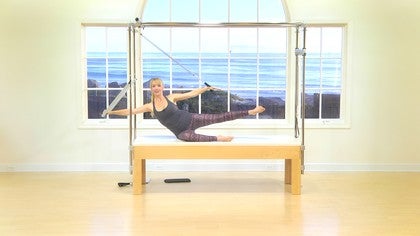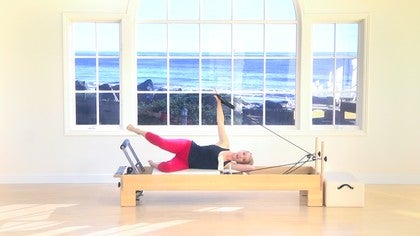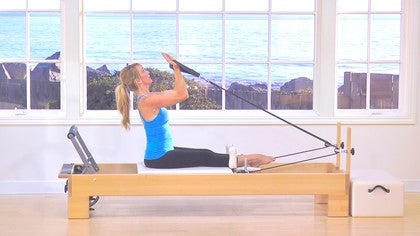Description
Before taking this class, you should try Leah's first Prenatal Mat Workout and her second Prenatal Mat Workout for gentle ways you can start moving before going back to Pilates exercises.
About This Video
Transcript
Read Full Transcript
Hi there. So you've had your baby and you are should be about six, seven, eight, maybe nine weeks. And I want to [inaudible] get you a reacquainted with the reformer postpartum. Um, I would definitely encourage you up to this point to do some of my earlier mat work classes for the postpartum [inaudible] and then when you get to about that two or even three month mark, um, professionally and personally, I feel that's really a good time to kind of get back on the equipment for me during both pregnancies. I waited till about six or seven weeks before I got back on the equipment, so I wanted to show you just some fun, a little bit of a short, uh, plotty session here for you that you can do postpartum that will feel really good on your body. So let's go ahead and get started.
And the joy of this is we can lie on our back, which we haven't been able to do for a while. So we're going to do a little bit of a warmup and I'm going to leave my foot bar up because I just feel like it's a little bit more comfortable, but I'm going to be placing my feet on the platform here and I want you to load your at spring up to about two and a half a spring. So just as a little bit of tension where you can move the reformer a little bit, but it's not too much light to where it's very unstable. So I want you to place your in steps on that platform there and depending on the equipment that you're working on, it may be a different size. So I want you to just lie.
So this time as you roll into your posts or you until you're going to drive your heels down, kind of like a prehensile position, you're going to push the carriage away. Then inhale, slowly release, lift your heels and come back and exhale, wrap those toes around. It's a real little drop in the heels, a little posterior tilt. You'll feel that deep connection with the pelvic and release. This is too intense. Go ahead and lower the way a little bit, but it just wants you to add a little bit of that hamstring work, a little bit deeper connection with the pelvic floor as we push the carriage out, just really gentle and last one exhale and back to center and wants you to bring your feet up onto the bar. Go ahead and take your arms out to the tee position.
Squeeze in those legs together. You're going to gently take the legs to one side, just rotating in the spine, breathing in, then XL, roll the feet back across the bar and roll the spine back across the mat. So in him, so in this early postpartum period, it's all about, like I've said before, just kind of guiding your body back to, I want to say too normal, because after you've been pregnant and after you've given birth, the reality is is a new normal, but you want to kind of guide your body back into the work and we need to do that very, very gently. And I know I, I sound like a broken record, but I can't emphasize that enough because I think in our culture we're too much pressure on a Saget our body back quickly after we have a baby. And the important thing is, is that we guide our body back so that it feels good. We don't create any problems that didn't exist and that we feel strong so that we can care for our little ones.
And we can be present with our little ones to the left. Inhale and Xcel back to central. Let's do one more set and inhale and back to center. Last one, she just feel really nice and loosen your spine and back to center. So now from here I want you to go ahead and take your hands back down by your sides. You're gonna bring your right foot onto the bar and you're going to release your left foot that it can come up.
You're just going to start by just drawing that left leg in. That left me toward the chest so you can see all my pelvis is tucked underneath me. Then inhale, I'm gonna rock the pelvis back toward the neutral and drop that foot down. So exhale. So don't do anything with the right leg yet. We're going to get there in just a moment. And Inhale rocket back to center one more time without moving the carriage.
Exhale. You can feel that deep pelvic floor connection here, that deep hip flexor connection on that left side back to center. Now you're going to add again the heel drop with the right leg and you're going to push the carriage back just a little bit. So I'm just getting a little bit of hamstring activation here in my right leg and come back to center, lift the heel up and XL, draw up the heel down. A little prehensile kind of like we did on the platform, but I'm just doing it in a higher position and back to center. Last one, XL at the pelvis. Initiate the role that the leg follow, drop that heel down and back to center. So it should feel quite different when you start to move the carriage.
So we're first going to do it with the carrier stays steady. So pool the pellets into the poster, your till, draw the right leg in, you'll feel that deep connection. Such a great gentle exercise, but effective exercise on just reawakening those pelvic floor muscles, reawakening the [inaudible], dominant muscles, nascent, gentle here as we're a couple months postpartum. And again, exhale and back to center. Now you're going to drop that left hill as you push the carriage exhale and back to center. So getting that hamstring work and rebuilding that strength in the glutes and they have strings. Getting in touch with that strength is going to be very important for our overall postural control, our alignment, which is going to help keep some of the discomfort and pain as a new motherhood away. Exhale and back to center. So that's just a very gentle kind of easy, warm up here. Go ahead and roll onto your side, set yourself up.
And I want to do a short footwork series here. So I want you to load up your screen to whatever you feel is comfortable. And again, remember your very early postpartum here. So I would probably encourage you to air on the lighter side just as you're regaining that pelvic stability and think of it more as kind of a exercise in that rather than really challenging that leg strength. So for me, I'm choosing to do three springs. You might do two and a half springs, whatever feels good for you. So lying back down, I want you to do parallel positions here. So flexing the feet, we're gonna push the carriage back with an exhale. So now in the prenatal work, when I did the modified positionings of the foot work, I talked a lot about expanding the pelvis.
We talked about engaging the pelvic floor too, but we've talked a lot about opening and mobilizing the pelvis, which was crucial for preparation for Labor and birth. Now postpartum, we kind of want to knit everything back together. We kind of want to help those, those muscles, that musculature kind of knit itself back together, kind of fuse back together if you want to think of it that way. So it's really nice to think as you're pushing the carriage out, I've kind of just gently narrowing into the front of the body. So you're just feeling that stability, the pelvis, you're feeling that we're cutting at the back of the legs. Then inhale, not so much of an expansion as you bring the carriage back in, but more of a release and exhale and inhale. And one more time. Exhale.
So now I want you to go onto the toes in the parallel position. Taking your breath into prepare an x out. Because the truth is, even though this work is on legs, there's still a lot going on with the pelvic floor. There's a lot going on with the abdominals. So you just really want to feel that nice, strong engagement for that pelvic stability and just feel everything. Again, coming together. I know I'm repeating myself, but just to get that idea in your mind and exhale and again, feeling that hip extension work, exhale, and in three more exhale, just nice and easy.
So even here, even the demands of this on your center body, you're going to feel that's that sensitivity, that healing. That's going on. I certainly do. I'm nine weeks postpartum here and I can feel that work. I still want to be really sensitive or I don't want to overdo it. And back to center.
Just sat in front of you. So we're going to do some of our prenatal type work that we did and our in our other series, but we're going to work on, again, just kind of safe abdominal work here. So we're going to draw the arms in with an inhale. Exhale, you're just going to gently roll back. Inhale, you're going to come up, then you're going to extend the arm. So this is going to be our first exercise. Draw the arms and elevate, extend the spine, pull the abdominal wall. Then roll the pelvis just slightly underneath. You. Inhale out
Inhale up and center. And I'd like you to do this same thing slightly rotated. So arms in and pool the body underneath. You can see how small I moving, how nice and tight everything is. Roll up and center, stay to the right arm, Zen and rule
You may feel that one side of your back or your waist is really tight and that's probably the side that you hold the baby on the most. So there's a little bit of an imbalance going there. So he really wants you to pay attention to that as you do this work on the rotation and it will be revealed to you and how tight that weeks' spills that lower back feels. And if your knees are kind of shifting and kind of wild here and the inability to keep your pelvis nice and square and straight and come up and forward. Inhale. So again, very gentle is we're reintroducing the reformer work and outlet time and rule and restock the spine and come forward.
So now I want you to hinge straight back. I want you to roll the pelvis underneath. You're going to keep your arms straight, dye the head forward. You'll get slapped on the spread on the strap here, which is fine, and come up into extended back silver hangy back pelvis underneath you. Diving the head down and come through just diving through space, rolling through space and I did a lot of this work in our prenatal series and there's no reason we can't enjoy it after we're pregnant and go forward.
Excuse me, back. Roll the pelvis underneath you rolling forward and bring it up. Now this time bend your elbows in. Take a little roll back from me. Now you're going to keep your elbows bent. You're going to take the arms out to the side XL, draw the scapulas together. One, so a little bit more challenging here. Draw the elbows out to the sides on the scapula together to keep the abdominal wall nice and tight here as you just see a little posterior tilt filling that closure of the ABS, that front of the body. Three.
I want six of these filling that work through the upper back. So then scapula gliding together. Two more for me. Exhale and last one. Exhale. Now this time, roll yourself up, realign your spine and do it again in a straight position. Exhale one so you can see my arms the same. Parallel the ground my wrist
The ability to open your chest and strengthen your upper back is so important for that maintenance of good posture when we're postpartum and you can try to hold your baby with good posture all day long. But the truth of it is that is in my opinion, it's not going to last very long. So we want to reconnect it with these exercises. We find that balance in the body come back to center and release. So we're going to do a little bit of hip work and we're going to actually go into, we're actually going to do some of our postpartum, excuse me, pre needle kind of positioning.
We're actually gonna take the straps and place them up over the knees on top of the thighs and I just want to work a little bit with some hip mobilizations and pelvic stabilization there. So go ahead and lie down on your side. I loaded my spring up to one and a half and I want you to gently take your straps all the way up over the knee onto the thigh with both legs. Now holding here, squeezing those legs together. We're going to set very simple. We're going to open the legs out to the side with a breath in and exhale close.
We're going to open the legs out to the side with a breath in and exhale close. So I'm moving the carriage a little bit, but I'm going to correct myself. I don't want it to move. I want you to keep just the right amount of tension on the straps where that carriage doesn't move forward and back and you'll feel that work starting to heat up and warm up below in the pelvis. So you're just drawing the pelvic floor musculature together.
The abductors together. Just squeeze those legs and back to center. Now here I want you to bring the legs in as far as you can to your chest, feeling that stretch to the lower back. Then activate the hip extensors and take it all the way back. And I actually want you to feel your legs go as far down as you can without losing that control. As soon as you fill the abdominal wall start to pop up, we start to feel the pelvis move or you just start to feel like you can't hold it anymore. I want you to stop and as you regain that strength, you're going to be able to go further and further. But by bending the knees, heaping the straps over the thighs, we're keeping that lever nice and short in the leg so that we're just making it slightly more doable for our very unstable pelvis, postpartum, and kind of that musculature that needs a lot of gentle rehabilitation after pregnancy and labor. So draw the knees in Nice and far and take them away. Very gentle. You'll feel that work deep in your pelvis.
So this is more of a series for that pelvic stabilization where they're to feel some of our traditional hip work care. We're not so concerned about that. One more time. Inhale and XL come back to the legs being parallel. Knee overhead wants you to open them up, extend the legs. You feel that nice stretch through the hamstrings, even through the adductors. Bend the knees and draw the legs back together.
So keep the carrots steady. So I told you I'm nine weeks postpartum here and I am very challenged here with my stability as I do this work. So don't be discouraged if you feel like you're all wiggly and wobbly. It's normal and these nice exercises will guide you back to that and up. Don't put your feet too hard like me.
You'll get some cramps to just keep your breath going. Nice and gentle here. Open the legs up, stretch, bend the knees and come back. Now to finish, I just want you to do some free circles with those hips. Again, not very big, nice and small, and even here's your jaw, the legs. Then you'll feel your lower back kind of. And onto the mat, which is fine. Just feeling that beautiful circling of the hips. Let's go the other direction and bring them up and around it. And, and I've been around and just filling that deep work in the hip, that mobilization of that Femur, just rotating around in the pelvis. Last one, come all the way in and just hug your knees into your chest for a moment and just find that rest.
So now I gently want you to bring your right leg out, foot on the bar, and carefully take your left leg out. Okay, so coming up for me,
So it wants you to start in a straight position, so you have a nice neutral spine, abdominal abdominal wall drawn in here. We're just going to start by gently rolling the pelvis underneath you. Exhale. Then inhale, rolling it back, reaching those sits bones out behind you and exhale, rolling the pelvis. Just beautifully drawing it in and releasing it as you come back. And this time I want you to just gently hold a here.
We're going to move very small here. Inhale, yeah,
Find the extension of the spine holding it here. Give me five more with the flat back. Inhale and exhale, beautiful, hinge at the hip and inhale and exit. This is actually a great way to build back up to some of our full plank positions. This is a very modified sort of plank position where we're required to have that nice full body, a stabilization and control, so really nice way to do this here as we get some nice hip mobility to regain some of that strength through the torso and through the center body. Go ahead and bring yourself all the way back down, sitting on your heels so that if that feels a little bit too much on the legs, it feels a little bit too much on the abdomen at this point in your postpartum period.
I would actually at this point encourage you to lighten the weight just a little bit. Now usually that would be if for some people harder on the abdominal wall, but because we're keeping the range of motion so small, meaning we're not taking the legs back very far, we're not going to have quite that same effect, so you can definitely try that for me. I want you to go ahead and bring your legs all the way together. Place your hands back on the shoulder rest and I just want you to lift your hips and open your chest and just find that nice stretch through the quads. Hopefully you can get it a little bit into the hip flexors and through the chest in the front of the shoulders. Hold this stretch here and then slowly release as you come down. We're going to try it again. Take your breath in and then exhale. Press those hips up.
Feel that wonderful stretch. You can try to pull your pelvis toward a tuck underneath you, meaning lift your pubic bone up and Gazer gluteal muscles to kind of press those hips forward to get a little bit deeper into the hips and slowly bring yourself all the way down. So I want to just do a little bit of extra arm work and then we did a little bit before and the arms sitting series. So go ahead and take your head down. I'm on one full spring and again, sitting with your legs straight forward. I want to do a little bit of our chest expansion here. So again, anything that we can do to open up that chest, draw the musculature and the activation into the upper back is really key here for your postpartum period. So arms reaching down, fingertips extended toward the floor, feeling the elevation, so even this is good work. So XL, press those arms back and bring them forward. So again, don't feel discouraged if this weight feels too heavy for you. Lighten it up.
It's very important that you had the stability through the torso so that you can keep that integrity through that stabilization as you move those arms, filling the triceps, filling the posterior shoulder as opposed to your delts, filling the lats, building that expansion at the front of the chest. Last to exhale and forward. Last one and forward. Bring those arms up nice and strong here. Bicep curl, exhale, so beautiful series arms sitting with so many different exercises that we can do. I'm going to just do a few biceps here and we're going to add some little gentle back extension to it with some shoulder work. Last one for me and hold it.
Now lift your back up, let your back initiate the movement and bring your arms up with it and slowly back. So you can see I'm not moving from my arms first. I'm actually moving from my back. So lift the backup, exhale and bring it forward and lift it up. Exhale and bring it forward to more. So again, this is the opportunity that if you need to work a little bit lighter you can and bring it forward. One more lift and bring it forward and release. So just a very nice short arm series. We're going to finish with some back extension with our long box.
So we're going to lie over facing the risers chest just over the edge of the box reaching forward on the outside of the reformer. I want you to start actually a little bit lower than parallel to the ground. Soon. Kind of dipping your head down toward the headrest and nice straight legs. So you're going to activate this movement by pulling the scapular down to pressing the Scapula. So exhale, then start to lift the head, neck and chest.
You'll feel the lats engage and keep reaching up and forward with your chest as you pull that carriage forward and reach all the way down. So again, scapular shoulders initiate head, neck and chest and the arms and the spine are moving in unison as you come forward. And then reach it all the way down. Two more just like that and XL. And again, don't be afraid to lighten your spring. You can do one full spring or a half the spring here and come all the way forward. Just feeling that beautiful. Strengthen your upper back. Last one, exhale and forward. So now we're going to continue.
I said last one. I guess I was kind of misleading you here cause I want you to lift your right leg this time up now, lower the leg down and bring it up. Lower the leg down as you've take the carriage back, pull the carriage forward. Bring it up, lower the leg down and bring it up and forward and this'll be our last side and bringing the leg up cares forward and back with the carriage leg down. Exhale up and down.
So a lot of work on the posterior chain of the body, the back of the shoulders, the spine, the back muscles, back of the hips. Last one, bring it up all the way down and just relax here. Push yourself up onto your box, stretching up at that resting at four head down, finding your breath. Just relaxing for me. Breathing into your back and as you are coming back into your [inaudible] repertoire, especially reintroducing your body to the reformer and to some of the apparatus, just finding fun ways to kind of bring in those ideas of pelvic floor reactivation, abdominal reactivation and just using the equipment creatively to be able to do that because you will get back to doing your full hip work and doing your hundred and doing some of your more advanced repertoire on the equipment. I know you will, but we need to get back there nice and safe.
And I need to go because I hear my son crying. And so my time is plotting is, is done, and I'm back to mommy mode. So just a nice sort reform recession for you because I know moms, we have very limited time. We're on a budget always, so thank you for joining me. If you have any questions, just let me know below and I'll be back in a couple more months to continue the postpartum series. Thank you.
Postnatal Pilates: Postnatal on the Apparatus
Comments
Lita - First, have so much fun with your clients as they enter this new phase of their lives, Pilates is such a great guide through all the transitions involved
 Second, I am so happy that you did the class and enjoyed the movement, thank you!
Second, I am so happy that you did the class and enjoyed the movement, thank you!
You need to be a subscriber to post a comment.
Please Log In or Create an Account to start your free trial.





















